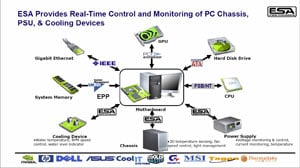NVIDIA ESA - Enthusiast System Architecture
ESA Enthusiast System Architecture

As it stands today, many of the major components in a typical enthusiast class PC have built-in mechanisms for monitoring the health status of the device. Processors and GPUs have internal thermal diodes for monitoring temperatures, and graphics cards and motherboards have sensors for monitoring a myriad of voltages and things like fan speeds. Other components, however, like cases, power supplies, and cooling systems, for example, usually don’t have any such mechanism. And even if they do, odds are it uses a proprietary interface that isn’t universally compatible.
To remedy this situation, the crew at NVIDIA has architected a new open standard the company hopes will be adopted across the industry. ESA, or the Enthusiast System Architecture, as it is known, was designed for real-time monitoring and control of PC power supplies, chassis and water cooling systems.
The ESA standard is built around the USB HID (Human Interface Device) specification and has been submitted to the USB-if HID subcommittee for discussion and approval. ESA is essentially a hardware and software interface that takes data collected by analog sensors and converts it to digital information that can accessed via software. Below are a handful of slides taken from an NVIDIA-produced presentation on ESA.


How Many GeForce 8800 Ultras Are In That System?
If you take a look at the slides above, they'll give you an idea as to what NVIDIA is trying to do with ESA. As you'll see, ESA compliant hardware will feature an embedded microcontroller and will connect to a system via a standard USB cable. Currently, NVIDIA has developed new software as an extension of their nTune system utility for use with ESA, but partners that may eventually build ESA compliant hardware can also incorporate the data into their own proprietary PC health monitoring / status applications, like Gigabyte's Easy Tune or Asus' PC Probe.
So, how would ESA compliant hardware affect you? As an example, consider a case. An ESA compliant case could have a number of thermal sensors throughout its interior and their positions throughout the enclosure are recorded in ROM. The fans used in the case are also connected to an ESA compliant controller. Should one of the thermal sensors in the case read a high temperature, the ESA microcontroller can instruct the necessary case fans to spin up, which will reduce the temperature. Cooling devices can also gain new functionality like real-time monitoring of water temperatures and flow-rates and controlled fans and pumps. And the data collected can be viewed through software or even by glancing down at LEDs that can be programmed to change colors in different scenarios. NVIDIA has put together a flash animation that demonstrates the many uses of ESA. Instead of reinventing the wheel and re-explaining everything here, we suggest you take a look at it. We've uploaded it here for your perusal.


The Microcontroller configuration and Software
On the surface, ESA holds a lot of promise. Its implementation, however, is up for some interpretation. NVIDIA has named a number of high-profile partners the company claims are backing the ESA standard, like Asus, Dell, CoolIT, Cooler Master, Gigabyte, MSI, Thermaltake, among others. While these companies may be on-board, how they specifically implement ESA in their products can vary considerably. ESA doesn’t define what aspects of a device need to be monitored or controlled, it defined the interface. So an ESA-compliant power supply from Vendor A may report voltages across all of its rails, core temperature, fan speeds, and ambient temperature, while Vendor B’s may simply report a single fans speed. NVIDIA has defined the standard for the interface, but not what each piece of hardware must report to be ESA compliant.
![]()
At the moment, we don’t have any word of specific ESA-compliant hardware in the works. We suspect some of the more enthusiast-friendly manufacturers will eventually introduce ESA compliant hardware of some sort in the future. The specific implementations, however, and the additional cost will be the ultimate indicators of ESA’s usefulness and success. We can certainly see the potential. Whether or not NVIDIA’s vision of ESA becomes reality, however, won’t be known for quite some time.






